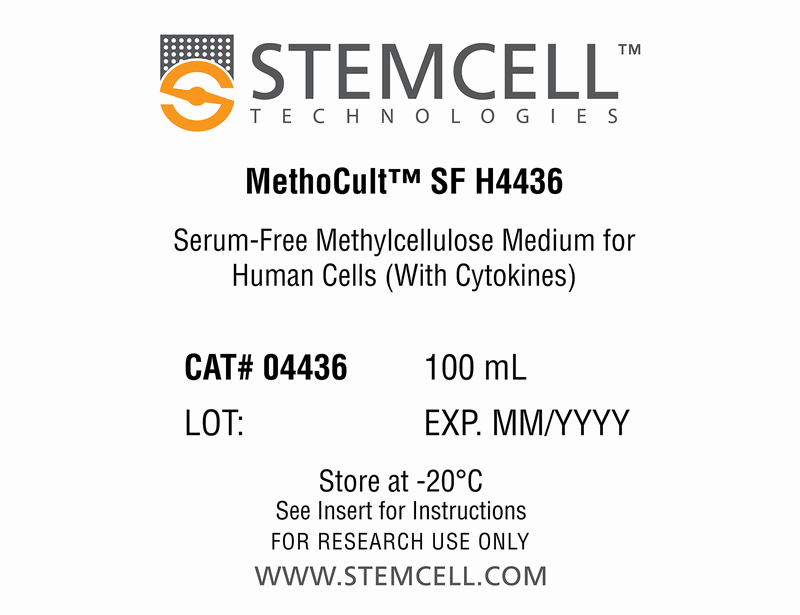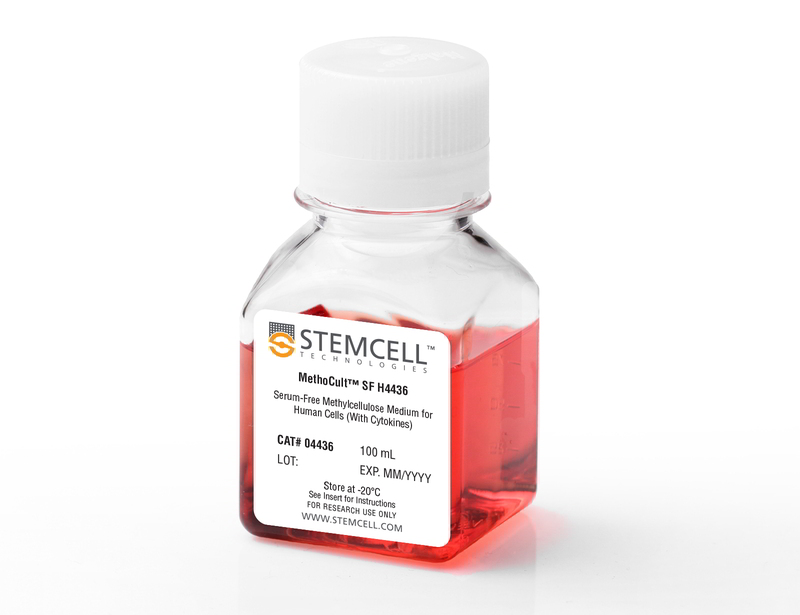MethoCult™ SF H4436
Serum-free methylcellulose-based medium with recombinant cytokines for human cells
概要
MethoCult™ SF H4436 is a complete serum-free methylcellulose-based medium for the growth and enumeration of hematopoietic progenitor cells in colony-forming unit (CFU) assays of human bone marrow, mobilized peripheral blood, peripheral blood, and cord blood samples. MethoCult™ SF H4436 is formulated to support optimal growth of erythroid progenitor cells (BFU-E and CFU-E), granulocyte-macrophage progenitor cells (CFU-GM, CFU-G and CFU-M), and multipotential granulocyte, erythroid, macrophage, megakaryocyte progenitors (CFU-GEMM) under defined serum-free conditions.
Browse our Frequently Asked Questions (FAQs) on performing the CFU assay and explore its utility as part of the cell therapy workflow.
Browse our Frequently Asked Questions (FAQs) on performing the CFU assay and explore its utility as part of the cell therapy workflow.
Contains
• Methylcellulose in Iscove's MDM
• Bovine serum albumin
• 2-Mercaptoethanol
• Recombinant human insulin
• Human transferrin (iron-saturated)
• Recombinant human stem cell factor (SCF)
• Recombinant human interleukin 3 (IL-3)
• Recombinant human interleukin 6 (IL-6)
• Recombinant human erythropoietin (EPO)
• Recombinant human granulocyte colony-stimulating factor (G-CSF)
• Recombinant human granulocyte-macrophage colony-stimulating factor (GM-CSF)
• Supplements
• Bovine serum albumin
• 2-Mercaptoethanol
• Recombinant human insulin
• Human transferrin (iron-saturated)
• Recombinant human stem cell factor (SCF)
• Recombinant human interleukin 3 (IL-3)
• Recombinant human interleukin 6 (IL-6)
• Recombinant human erythropoietin (EPO)
• Recombinant human granulocyte colony-stimulating factor (G-CSF)
• Recombinant human granulocyte-macrophage colony-stimulating factor (GM-CSF)
• Supplements
Subtype
Semi-Solid Media, Specialized Media
Cell Type
Hematopoietic Stem and Progenitor Cells
Species
Human
Application
Cell Culture, Colony Assay, Functional Assay
Brand
MethoCult
Area of Interest
Stem Cell Biology
Formulation
Serum-Free
技术资料
| Document Type | 产品名称 | Catalog # | Lot # | 语言 |
|---|---|---|---|---|
| Product Information Sheet | MethoCult™ SF H4436 | 04436 | All | English |
| Manual | MethoCult™ SF H4436 | 04436 | All | English |
| Safety Data Sheet | MethoCult™ SF H4436 | 04436 | All | English |
数据及文献
Publications (15)
Stem Cell Reports 2014 DEC
Tenascin C promotes hematoendothelial development and T lymphoid commitment from human pluripotent stem cells in chemically defined conditions
Abstract
Abstract
The recent identification of hemogenic endothelium (HE) in human pluripotent stem cell (hPSC) cultures presents opportunities to investigate signaling pathways that are essential for blood development from endothelium and provides an exploratory platform for de novo generation of hematopoietic stem cells (HSCs). However, the use of poorly defined human or animal components limits the utility of the current differentiation systems for studying specific growth factors required for HE induction and manufacturing clinical-grade therapeutic blood cells. Here, we identified chemically defined conditions required to produce HE from hPSCs growing in Essential 8 (E8) medium and showed that Tenascin C (TenC), an extracellular matrix protein associated with HSC niches, strongly promotes HE and definitive hematopoiesis in this system. hPSCs differentiated in chemically defined conditions undergo stages of development similar to those previously described in hPSCs cocultured on OP9 feeders, including the formation of VE-Cadherin(+)CD73(-)CD235a/CD43(-) HE and hematopoietic progenitors with myeloid and T lymphoid potential.
Regenerative medicine 2013 JUL
3D microcarrier system for efficient differentiation of human pluripotent stem cells into hematopoietic cells without feeders and serum [corrected].
Abstract
Abstract
BACKGROUND Human embryonic stem cells (hESCs) have been derived and maintained on mouse embryonic fibroblast feeders to keep their undifferentiated status. To realize their clinical potential, a feeder-free and scalable system for large scale production of hESCs and their differentiated derivatives is required. MATERIALS & METHODS hESCs were cultured and passaged on serum/feeder-free 3D microcarriers for five passages. For embryoid body (EB) formation and hemangioblast differentiation, the medium for 3D microcarriers was directly switched to EB medium. RESULTS hESCs on 3D microcarriers maintained pluripotency and formed EBs, which were ten-times more efficient than hESCs cultured under 2D feeder-free conditions (0.11 ± 0.03 EB cells/hESC input 2D vs 1.19 ± 0.32 EB cells/hESC input 3D). After replating, EB cells from 3D culture readily developed into hemangioblasts with the potential to differentiate into hematopoietic and endothelial cells. Furthermore, this 3D system can also be adapted to human induced pluripotent stem cells, which generate functional hemangioblasts with high efficiency. CONCLUSION This 3D serum- and stromal-free microcarrier system is important for future clinical applications, with the potential of developing to a GMP-compatible scalable system.
Blood 2012 JUN
APELIN promotes hematopoiesis from human embryonic stem cells.
Abstract
Abstract
Transcriptional profiling of differentiating human embryonic stem cells (hESCs) revealed that MIXL1-positive mesodermal precursors were enriched for transcripts encoding the G-protein-coupled APELIN receptor (APLNR). APLNR-positive cells, identified by binding of the fluoresceinated peptide ligand, APELIN (APLN), or an anti-APLNR mAb, were found in both posterior mesoderm and anterior mesendoderm populations and were enriched in hemangioblast colony-forming cells (Bl-CFC). The addition of APLN peptide to the media enhanced the growth of embryoid bodies (EBs), increased the expression of hematoendothelial genes in differentiating hESCs, and increased the frequency of Bl-CFCs by up to 10-fold. Furthermore, APLN peptide also synergized with VEGF to promote the growth of hESC-derived endothelial cells. These studies identified APLN as a novel growth factor for hESC-derived hematopoietic and endothelial cells.
Blood 2010 OCT
TAT-mediated transduction of NF-Ya peptide induces the ex vivo proliferation and engraftment potential of human hematopoietic progenitor cells.
Abstract
Abstract
Retroviral overexpression of NF-Ya, the regulatory subunit of the transcription factor NF-Y, activates the transcription of multiple genes implicated in hematopoietic stem cell (HSC) self-renewal and differentiation and directs HSCs toward self-renewal. We asked whether TAT-NF-Ya fusion protein could be used to transduce human CD34(+) cells as a safer, more regulated alternative approach to gene therapy. Here we show that externally added recombinant protein was able to enter the cell nucleus and activate HOXB4, a target gene of NF-Ya, using real-time polymerase chain reaction RNA and luciferase-based protein assays. After TAT-NF-Ya transduction, the proliferation of human CD34(+) cells in the presence of myeloid cytokines was increased 4-fold. Moreover, TAT-NF-Ya-treated human primary bone marrow cells showed a 4-fold increase in the percentage of huCD45(+) cells recovered from the bone marrow of sublethally irradiated, transplanted NOD-Scid IL2Rγ(null) mice. These data demonstrate that TAT-peptide therapies are an alternative approach to retroviral stem cell therapies and suggest that NF-Ya peptide delivery should be further evaluated as a tool for HSC/progenitors ex vivo expansion and therapy.
Blood 2010 DEC
Retinoic acid enhances the generation of hematopoietic progenitors from human embryonic stem cell-derived hemato-vascular precursors.
Abstract
Abstract
Current induction schemes directing hematopoietic differentiation of human embryonic stem cells (hESCs) are not well defined to mimic the sequential stages of hematopoietic development in vivo. Here, we report a 3-stage method to direct differentiation of hESCs toward hematopoietic progenitors in chemically defined mediums. In the first 2 stages, we efficiently generated T-positive primitive streak/mesendoderm cells and kinase domain receptor-positive (KDR(+)) platelet-derived growth factor receptor α-negative (PDGFRα(-)) hemato-vascular precursors sequentially. In the third stage, we found that cells in a spontaneous differentiation condition mainly formed erythroid colonies. Addition of all-trans retinoic acid (RA) greatly enhanced generation of hematopoietic progenitors in this stage while suppressing erythroid development. The RA-treated cells highly expressed definitive hematopoietic genes, formed large numbers of multilineage and myeloid colonies, and gave rise to greater than 45% CD45(+) hematopoietic cells. When hematopoietic progenitors were selected with CD34 and C-Kit, greater than 95% CD45(+) hematopoietic cells could be generated. In addition, we found that endogenous RA signaling at the second stage was required for vascular endothelial growth factor/basic fibroblast growth factor-induced hemato-vascular specification, whereas exogenously applied RA efficiently induced KDR(-)PDGFRα(+) paraxial mesoderm cells. Our study suggests that RA signaling plays diverse roles in human mesoderm and hematopoietic development.
Journal of immunological methods 2008 MAR
Increased production of megakaryocytes near purity from cord blood CD34+ cells using a short two-phase culture system.
Abstract
Abstract
Expansion of hematopoietic progenitor cells (HPC) ex vivo remains an important focus in fundamental and clinical research. The aim of this study was to determine whether the implementation of such expansion phase in a two-phase culture strategy prior to the induction of megakaryocyte (Mk) differentiation would increase the yield of Mks produced in cultures. Toward this end, we first characterized the functional properties of five cytokine cocktails to be tested in the expansion phase on the growth and differentiation kinetics of CD34+-enriched cells, and on their capacity to expand clonogenic progenitors in cultures. Three of these cocktails were chosen based on their reported ability to induce HPC expansion ex vivo, while the other two represented new cytokine combinations. These analyses revealed that none of the cocktails tested could prevent the differentiation of CD34+ cells and the rapid expansion of lineage-positive cells. Hence, we sought to determine the optimum length of time for the expansion phase that would lead to the best final Mk yields. Despite greater expansion of CD34+ cells and overall cell growth with a longer expansion phase, the optimal length for the expansion phase that provided greater Mk yield at near maximal purity was found to be 5 days. Under such settings, two functionally divergent cocktails were found to significantly increase the final yield of Mks. Surprisingly, these cocktails were either deprived of thrombopoietin or of stem cell factor, two cytokines known to favor megakaryopoiesis and HPC expansion, respectively. Based on these results, a short resource-efficient two-phase culture protocol for the production of Mks near purity (textgreater95%) from human CD34+ CB cells has been established.


